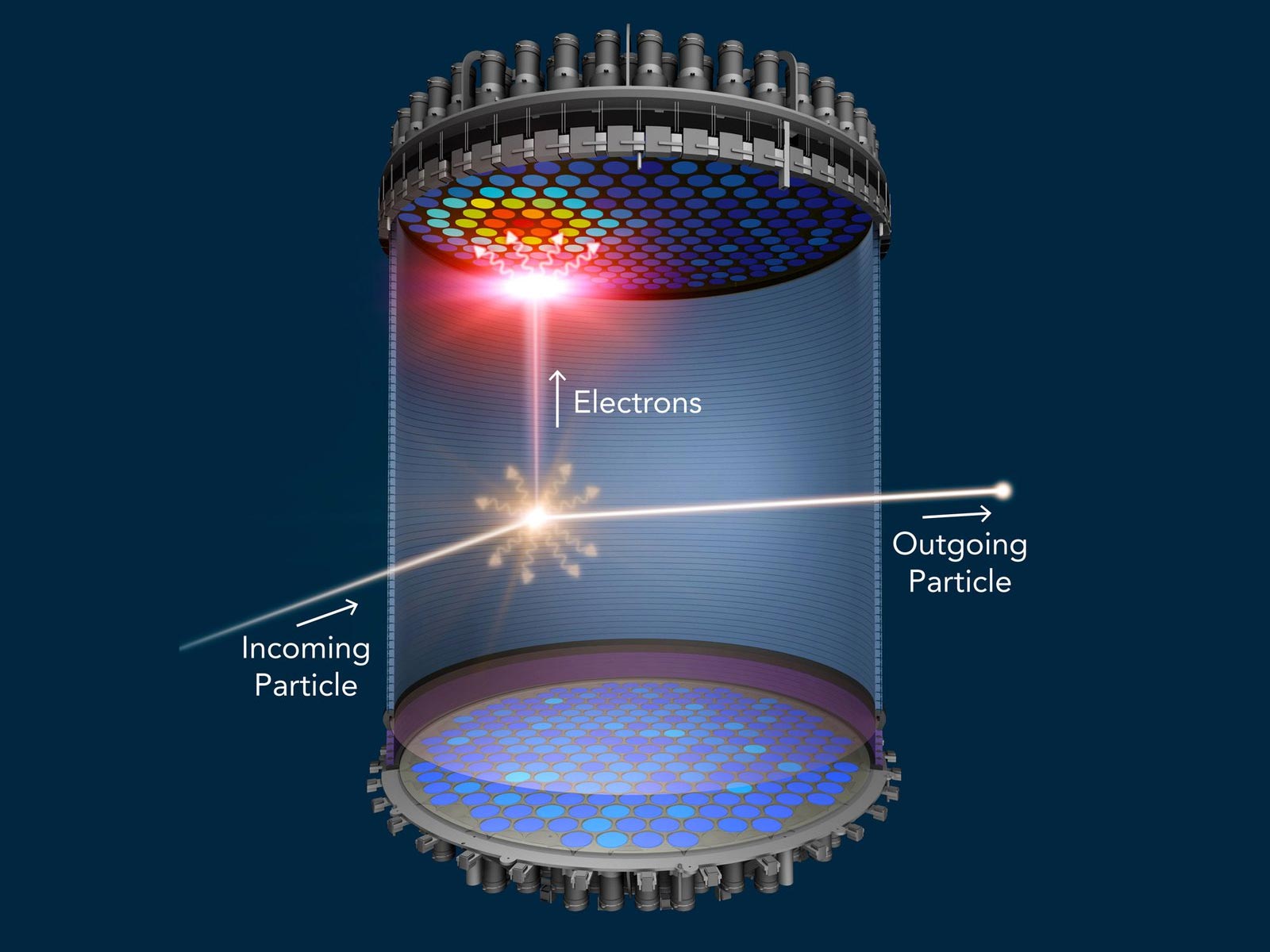
Členové týmu LZ v nádrži na vodu LZ po instalaci externího detektoru. Kredit: Matthew Capost, Sanford Underground Research Facility
Výzkumníci z Berkeley Lab zaznamenali úspěšné spuštění detektoru temné hmoty LUX-ZEPLIN v Sanford Underground Research Facility
Inovativní a jedinečně citlivý detektor temné hmoty Luxusní Zeppelin (LZ) Experiment – prošel fází odhlášení spouštěcích procesů a poskytl první výsledky. LZ se nachází hluboko v Black Hills v Jižní Dakotě Sanfordské podzemní výzkumné zařízení (SURF) a je vedena Národní laboratoří Lawrence Berkeley (Berkeley Laboratory) Ministerstva energetiky.
„Jsme připraveni a vše vypadá dobře,“ řekl hlavní fyzik Berkeley Lab a bývalý mluvčí LZ Kevin Lesko. „Je to složitý detektor s mnoha součástmi a všechny fungují dobře v rámci očekávání,“ řekl.
V článku publikovaném 7. července o experimentu webová stránkaVědci z LZ hlásí, že po prvním uvedení do provozu se LZ již stal nejcitlivějším detektorem temné hmoty na světě. Článek se později objeví v online předtiskovém archivu arXiv.org. Mluvčí LZ Hugh Lippincott z Kalifornské univerzity v Santa Barbaře řekl: „V nadcházejících letech plánujeme shromáždit asi 20krát více dat, takže jsme teprve na začátku. Je potřeba udělat hodně vědy, což je velmi vzrušující.“ !“

Prozkoumejte LZ vnější detektor, který se používá k vetování radioaktivity, která může simulovat signál temné hmoty. Kredit: Matthew Capost/Sanford Underground Research Facility
Zatímco temná hmota Částice nejsou ve skutečnosti detekovány, nemusí být pravdivé již mnohem déle. Odpočítávání již mohlo začít s výsledky z prvních 60 dnů živého testování LZ. Tato data byla shromážděna za tři a půl měsíce počátečního provozu od konce prosince. To bylo dostatečně dlouhé, aby se ujistil, že všechny strany detektoru fungují správně.
Přestože je neviditelná, protože nevyzařuje, neabsorbuje ani nerozptyluje světlo, existence temné hmoty a gravitace jsou přesto zásadní pro naše chápání vesmíru. Například přítomnost temné hmoty, která se odhaduje na asi 85 procent celkové hmoty vesmíru, utváří tvar a pohyb galaxií a výzkumníci ji citují, aby vysvětlili, co je známo o této rozsáhlé struktuře. a rozšiřování vesmíru.
Dvě vnořené titanové nádrže naplněné deseti tunami ultračistého kapalného xenonu lze sledovat pomocí dvou polí fotonásobičů (PMT) schopných detekovat slabé zdroje světla z jádra detektoru temné hmoty LZ. Titanové nádrže jsou umístěny ve větším systému detektorů, aby zachytily částice, které mohou napodobovat signál temné hmoty.
„Jsem potěšena, že vidím tento složitý detektor připravený řešit dlouhodobý problém, z čeho se skládá temná hmota,“ řekla Natalie Palanque Delabruille, ředitelka oddělení fyziky v Berkeley Lab. „Tým LZ má nyní k tomu nejambicióznější nástroj!“
Fáze návrhu, výroby a instalace detektoru LUX-ZEPLIN vedl projektový manažer Berkeley Lab Gil Gilchriese ve spolupráci s mezinárodním týmem 250 vědců a inženýrů z více než 35 institucí v USA, Velké Británii, Portugalsku a Jižní Koreji. Provozní ředitel LZ Simon Fiorucci z Berkeley Lab. Společně doufají, že pomocí přístroje zaznamenají první přímý důkaz temné hmoty neboli takzvané chybějící hmoty ve vesmíru.
Henrique Araujo, od[{“ attribute=““>Imperial College London, leads the UK groups and previously the last phase of the UK-based ZEPLIN-III program. He worked very closely with the Berkeley team and other colleagues to integrate the international contributions. “We started out with two groups with different outlooks and ended up with a highly tuned orchestra working seamlessly together to deliver a great experiment,” Araújo said.
An underground detector
Tucked away about a mile underground at SURF in Lead, South Dakota, LUX-ZEPLIN is designed to capture dark matter in the form of weakly interacting massive particles (WIMPs). The experiment is underground to protect it from cosmic radiation at the surface that could drown out dark matter signals.
Particle collisions in the xenon produce visible scintillation or flashes of light, which are recorded by the PMTs, explained Aaron Manalaysay from Berkeley Lab who, as physics coordinator, led the collaboration’s efforts to produce these first physics results. “The collaboration worked well together to calibrate and to understand the detector response,” Manalaysay said. “Considering we just turned it on a few months ago and during COVID restrictions, it is impressive we have such significant results already.”

When a WIMP – a hypothetical dark matter particle – collides with a xenon atom, the xenon atom emits a flash of light (gold) and electrons. The flash of light is detected at the top and bottom of the liquid xenon chamber. An electric field pushes the electrons to the top of the chamber, where they generate a second flash of light (red). LZ will be searching for a particular sequence of flashes that cannot be due to anything other than WIMPs. Credit: LZ/SLAC
The collisions will also knock electrons off xenon atoms, sending them to drift to the top of the chamber under an applied electric field where they produce another flash permitting spatial event reconstruction. The characteristics of the scintillation help determine the types of particles interacting in the xenon.
The South Dakota Science and Technology Authority, which manages SURF through a cooperative agreement with the U.S. Department of Energy, secured 80 percent of the xenon in LZ. Funding came from the South Dakota Governor’s office, the South Dakota Community Foundation, the South Dakota State University Foundation, and the University of South Dakota Foundation.
Mike Headley, executive director of SURF Lab, said, “The entire SURF team congratulates the LZ Collaboration in reaching this major milestone. The LZ team has been a wonderful partner and we’re proud to host them at SURF.”

Chemists at Brookhaven Lab used this custom-made vacuum distillation system to purify linear alkyl benzene needed to produce liquid scintillator for the LZ dark matter experiment. Credit: Brookhaven Lab
Fiorucci said the onsite team deserves special praise at this startup milestone, given that the detector was transported underground late in 2019, just before the onset of the COVID-19 pandemic. He said with travel severely restricted, only a few LZ scientists could make the trip to help on site. The team in South Dakota took excellent care of LZ.
“I’d like to second the praise for the team at SURF and would also like to express gratitude to the large number of people who provided remote support throughout the construction, commissioning and operations of LZ, many of whom worked full time from their home institutions making sure the experiment would be a success and continue to do so now,” said Tomasz Biesiadzinski of SLAC, the LZ detector operations manager.
“Lots of subsystems started to come together as we started taking data for detector commissioning, calibrations and science running. Turning on a new experiment is challenging, but we have a great LZ team that worked closely together to get us through the early stages of understanding our detector,” said David Woodward from Pennsylvania State University who coordinates the detector run planning.

The LZ central detector in the clean room at Sanford Underground Research Facility after assembly, before beginning its journey underground. Credit: Matthew Kapust, Sanford Underground Research Facility
Maria Elena Monzani of SLAC, the Deputy Operations Manager for Computing and Software, said “We had amazing scientists and software developers throughout the collaboration, who tirelessly supported data movement, data processing, and simulations, allowing for a flawless commissioning of the detector. The support of NERSC [National Energy Research Scientific Computing Center] Bylo to neocenitelné.“
S potvrzením, že LZ a jeho systémy fungují úspěšně, řekl Lesko, je čas zahájit pozorování ve velkém měřítku v naději, že se částice temné hmoty srazí s xenonem.[{“ attribute=““>atom in the LZ detector very soon.
LZ is supported by the U.S. Department of Energy, Office of Science, Office of High Energy Physics and the National Energy Research Scientific Computing Center, a DOE Office of Science user facility. LZ is also supported by the Science & Technology Facilities Council of the United Kingdom; the Portuguese Foundation for Science and Technology; and the Institute for Basic Science, Korea. Over 35 institutions of higher education and advanced research provided support to LZ. The LZ collaboration acknowledges the assistance of the Sanford Underground Research Facility.

Přátelský webový obhájce. Odborník na popkulturu. Bacon ninja. Tvrdý twitterový učenec.



